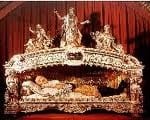 Among the recent additions to the Vincentian image archive includes photos disproving a spate of article claiming that Vincent’s body was incorrupt. Fr. John Rybolt writes, “I added a series under Vincent de Paul that I am calling “Exhumation,” although that isn’t the most accurate title. In 1960, the 300th anniversary of his death, his remains were removed from the silver shrine above the altar in the mother house in Paris for cleaning and rearranging. This was done in the company of a physician, a notary, the superior general (Fr. Slattery) and his council, and the superioress general (Sr. Lépicard) and her council. One reason for posting these is to overcome the recent spate of accounts about the saint’s body being incorrupt. You can see for yourself that it is not true. In addition, one of the last photographs shows the wax mask that was added over his skull, which had been previously covered with silk and red tape sealed with a wax seal.”
Among the recent additions to the Vincentian image archive includes photos disproving a spate of article claiming that Vincent’s body was incorrupt. Fr. John Rybolt writes, “I added a series under Vincent de Paul that I am calling “Exhumation,” although that isn’t the most accurate title. In 1960, the 300th anniversary of his death, his remains were removed from the silver shrine above the altar in the mother house in Paris for cleaning and rearranging. This was done in the company of a physician, a notary, the superior general (Fr. Slattery) and his council, and the superioress general (Sr. Lépicard) and her council. One reason for posting these is to overcome the recent spate of accounts about the saint’s body being incorrupt. You can see for yourself that it is not true. In addition, one of the last photographs shows the wax mask that was added over his skull, which had been previously covered with silk and red tape sealed with a wax seal.”
Other recent additions include a large number of art works that I collected in Germany, mostly of St. Vincent and St. Louise. Many new items have been added to Vincentian places (particularly to Paris, where I have uploaded photographs taken about 1903 on glass negatives from the original St. Lazare and from the Vincentian mother house.) These were recently printed professionally.
The St. Vincent de Paul Image Archive, to use its proper name, continues to grow in the number of images being posted. DePaul University hosts this collection of images, and it can be accessed by clicking on this url: http://stvincentimages.cdm.depaul.edu/,
or by clicking on thelink on the right side of this home page, or even by going to Google and typing in some approximation of its title.
The image archive front page has a block of four illustrations. By pointing your cursor and hovering over one of them, the image will turn from black and white into color; click on that and you are into the various categories. The four categories are: St. Vincent de Paul; St. Louise de Marillac and the Daughters of Charity; Vincentian places; and Vincentian persons (understood in a broad sense.)
Among the Vincentian persons I have a category that has been greatly expanded, dealing with contemporaries of Vincent de Paul, mainly portraits of individuals mentioned in his writings or who were active in his period. Many more could be added. A sub-set of these is “Activities,” which consists of people from the period engaged in numerous activities, including samples of clothing. One gruesome set is a portrayal of the tortures and punishments in use in Algeria in his time.
There is also a series of engravings about the celebration of Mass as depicted in 1651, exactly in his time. It is interesting to see how the Eucharist is linked to various events in the Passion of Jesus.
These images are free to download and use, but are not to be sold. They could be used for fund raising purposes, however. Where I have doubts about whether an image has been copyrighted, I try to note that along with the description of the image.
Father Rybolt writes..”I am always happy to receive additional images that would fit into any of the categories. My e-mail address for the image archive is: jerybolt@gmail.com”
There are two additional note to be found among the recent posts to the Vincentian History Researchers Network.
The first seeks information about parishes using income generating projects as part of a research project investigating parish based, income generating economic production (what we will call “parish based social business ventures”) is an important component of the Vincentian legacy.
Research Question: What are two or three of the best examples in Vincentian history of income generating activity from production (that is NOT fundraising or rent from property ownernship), preferably centered in or around a parish? In other words, what are some examples of products that were made and sold in the marketplace that were created by or managed by CMs, DCs, or other Vincentian organizations?
The second additional item is the announcement the Father Ed Udovic’s classic study of Vincentian Renewal under John Baptiste Ettienne has been translated into Spaniosh.
Tags: Vincent

